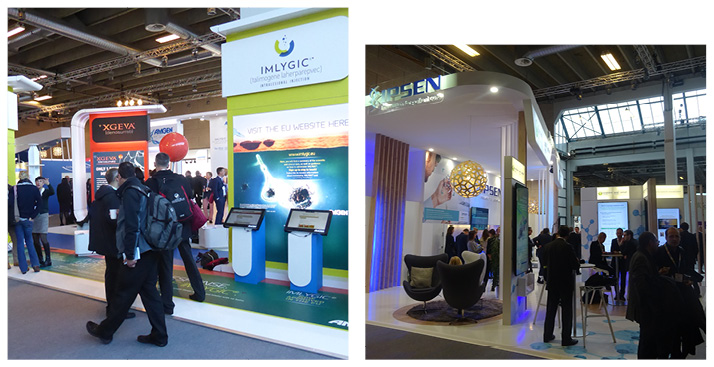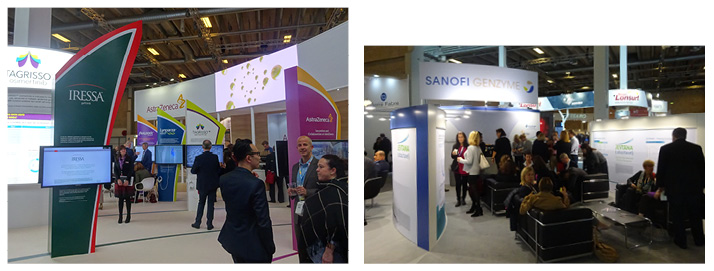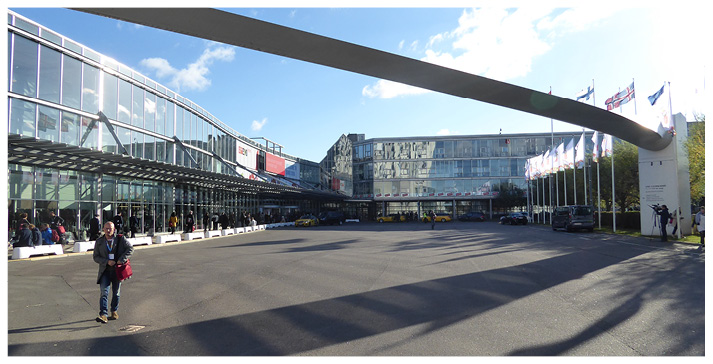This year, Copenhagen played host to the annual ESMO Congress which took place over 5 days and welcomed 20,522 participants. During the closing press conference, Prof Andrés Cervantes, Scientific Chair of the ESMO 2016 Congress, commented: “ESMO 2016 Congress has broken records, not only of attendance, but in terms of the quality science being presented that will impact the practice of oncology.”
Over 1,640 studies were presented, including 47 late-breaking trials and over 1,500 posters. The leading countries contributing to this year’s vast number of delegates were: the USA, France, the UK, Germany, Spain, Switzerland, Italy, China, Japan, and Denmark. Prof Cervantes noted the importance of such a popular and successful congress, stating: “This is certainly a record number, but what is most important is the good news for physicians and patients in many areas of unmet needs such as ovarian cancer, lung cancer, renal cell carcinoma, sarcomas, and other less common diseases.”
Prof Solange Peters, ESMO 2016 Press Officer and member of the EMJ Oncology Editorial Board, reflected on the most prominent aspects of the congress: “The accent on immunotherapy, that has changed the oncology landscape, as well as targeted therapies and personalised medicine in general; the use of biomarkers for predicting response and outcomes is of huge benefit to patients. Beyond data, our pre-occupation is about patients; that is why a study on quality of life, beyond survival, was included in a Presidential Symposium. That is also why we have a hugely successful Patient Advocacy Track and we also publish guidelines for cancer patients.”
During the Women for Oncology Session, Prof Sumitra Thongprasert was awarded the ESMO Women for Oncology Award for her career as a distinguished role model for women in oncology among countless other achievements. Three renowned oncologists were also presented with ESMO awards in the opening session of the congress: Prof Alberto Sobrero was presented with the ESMO Award for his remarkable original work and countless publications in the field of gastrointestinal cancers; Prof Carlos Caldas received the Hamilton Fairley Award for his outstanding contributions to cancer science and clinical/translational research; and Prof Sir Richard Peto was awarded the ESMO Lifetime Achievement Award, recognising his extensive involvement in cancer research and education.
Prof Ulrik Lassen, ESMO National Representative for Denmark and Local Officer for the ESMO 2016 Congress, stated: “ESMO brought us a lot of information in terms of better practice and science, and we will be busy in the coming months finding ways to integrate this new knowledge into our oncology practice.”
In the following congress review section, we bring you descriptions of some of the most impactful presentations that were made at the event. This includes a vast range of possible new treatments for conditions such as non-small cell lung cancer, breast cancer, and ovarian cancer. In addition, there is coverage of a study which looked at the issue of the lack of reporting on adverse events in targeted therapy and immunotherapy trials, and another which analysed the financial implications that face cancer patients around the world in regard to their treatment, amongst many others.
Following the clear success of this year’s congress, we look forward to reviewing the next ESMO annual congress in Madrid, Spain, in 2017.

ESMO-MCBS: A Quantification Tool for the Treatment of Rare Cancers
THE FIRST practicality study to assess the potential application of the ESMO-Magnitude of Clinical Benefit Scale (ESMO-MCBS) tool within clinical practice has shown promising results, as presented in a ESMO press release dated 10th October 2016.
Developed and first analysed in field testing by the Medical University of Vienna (MUV), Vienna, Austria, one of the largest cancer research centres in Europe, a second study of the ESMO-MCBS tool has reflected that its applications may extend even further to potentially become a global online implement for the assessment and treatment of rare cancers.
The ESMO-MCBS considers predefined drug trial endpoints, overall survival and progression-free rates, and corresponding quality of life or toxicity results. Developed as a three-step approach, this innovative study retrospectively acquired data on common treatments presently used throughout practice, before assessing these with the ESMO-MCBS and evaluating the overall grades to ascertain the feasibility of their use within a real-life clinical context. The study looked particularly at neuroendocrine tumours, glioblastoma, sarcomas, and thyroid, pancreatic, ovarian, head/neck, and urothelial cancers.
Of particular interest, the study obtained supporting data on the clinical benefit of CHECKMATE 141 checkpoint inhibitors, which scored an EMSO-MCBS value of 3, consistent with the results seen in practice. However, it was noted that the scale’s use for the treatment of rare cancers is limited by the volume and variety of published clinical trial data. Dr Barbara Kiessewetter, Clinical Division of Oncology, Medical University of Vienna, Vienna, Austria, explained, “We found that the ESMO-MCBS is a helpful tool for clinical practice in rare tumours, as well as for common tumour entities, if randomised data is available. It supports treatment decisions based on the expected clinical benefit. It is very simple to use and we feel that it is going to prove to be a very important tool for daily clinical practice based on our study results. Clinicians can go back to the data when considering new treatments and use the ESMO-MCBS online to analyse what can be expected from a new approach.”
Are Fibroblastic Growth Factor Receptor Inhibitors the Future for Rare Cancer Treatment?
THE FIRST dose escalation study in humans of pan-fibroblast growth factor receptor (FGFR) inhibitor BAY 1163877 has been investigated for its utility as a potential treatment of locally advanced or metastatic tumours, discussed in a ESMO press release dated 8th October 2016.
FGFR expression is often dysregulated via both epigenetic and genetic mechanisms in many types of cancer, particularly in bladder cancers. This potent, oral, novel anticancer therapy is designed to inhibit FGFRs 1–3, meaning the messenger RNA (mRNA) expression levels of FGFR in each individual patient may correlate with the potential benefit of BAY 1163877 therapy thus acting as a sensitive biomarker. Dr Markus Joerger, attending Medical Oncologist, St Gallen Cancer Centre, St Gallen, Switzerland, explained: “Most studies of FGFR inhibitors have looked at FGFR abnormalities in tumours with limited success. This study used an innovative biomarker approach for tumour FGFR mRNA expression.”
Conducted across six countries, this multicentre Phase I trial enrolled a total of 80 patients; 23 for a dose-escalation phase and 57 for an expansion phase. The type of cancer exhibited by each individual was not limited within this study, and included but was not limited to, bladder cancer, head and neck cancer, and lung cancer.
Patients were divided into six dose cohorts, ranging from 50–800 mg twice daily. No dose-limiting toxicities were observed; the majority of patients developed slight hyperphosphataemia, however, this is seen with all FGFR inhibitors. As a result, it is recommended that the maximum concentration of 800 mg be used in further Phase III trials. Within the expansion cohort 3 out of 8 bladder cancer patients showed partial remission. Patients with squamous cell carcinoma of the head and neck, squamous cell lung cancer, and adenoid cystic carcinoma were also observed to exhibit partial remission.
Prof Giuseppe Curigliano, Chair of the Division of Early Drug Development Therapeutics, European Institute of Oncology, Milan, Italy, commented: “FGFR inhibitors may provide a therapeutic opportunity to patients with rare tumours.”

Optimism for the Future of Metastatic Bladder Cancer Treatment
METASTATIC bladder cancer patients who are not eligible for current cisplatin-based chemotherapy could benefit from immunotherapy. A ESMO press release dated 8th October 2016 elucidated the promising results of two recent Phase II trials measuring the safety and efficacy of these classes of drugs in first and second line treatment of the disease.
Researchers presented data on the first 100 patients to be studied in the Phase II KEYNOTE-052 trial; this study tested a programmed cell death-1 (PD-1) blockade with pembrolizumab as first-line therapy in patients suffering from metastatic or locally advanced bladder cancer, who were not eligible for cisplatin. The primary endpoint of an objective response rate of 24% was targeted. At the time of the presentation, the median duration of response had not yet been reached and treatment had been well-tolerated. The biomarker cut point identifying patients most likely to respond to treatment was set at ≥10% total PD-L1 expression in immune cells or tumour cells, and 30 patients achieved this. Eleven of these patients (37%) responded to treatment.
The second Phase II study, CHECKMATE 275, evaluated 265 metastatic bladder cancer patients who had progressed following first line platinum-based chemotherapy. The team studied the PD-1 inhibitor nivolumab, assessing its safety and activity with the primary endpoint: an objective response rate of 19.6%. The median follow-up of the study was 7 months but median duration of response had not been reached. The objective response rate in the study was found to be higher than historically achieved with chemotherapy, for patients with tumours expressing either higher or lower levels of PD-L1.
Dr Maria De Santis, Associate Clinical Professor for Oncology, Cancer Research Centre, Warwick Medical School, University of Warwick, Coventry, UK, commented: “Immune checkpoint inhibitors have started to alter the therapeutic landscape for bladder cancer. We expect even more dramatic changes in the coming years with the use of immunotherapy in other clinical stages and as combination therapy.”
Poor Reporting of Adverse Events in Targeted Therapy and Immunotherapy Trials
REPORTING of adverse events in trials of targeted therapies and immunotherapies has been suboptimal in recent years, thereby withholding vital information about the safety of drugs, according to research presented in a ESMO press release dated 5th October 2016.
For this study, the publications of 81 trials for the treatment of solid malignancies in adult patients approved by the US Food and Drug Administration (FDA) were assessed. Over 90% of the trials scored poorly in reporting recurrent and late toxicities as well as the true duration of adverse events. Additionally, the time point of the adverse event occurrence was not adequately reported in 86% of the trials and only adverse events that occurred at a frequency above the fixed threshold were reported in 75% of published trials.
Limitations in the method for presenting adverse events, in the follow-up interval assessment, and in describing toxicities leading to therapy withdrawal, were found in over half of the publications assessed. Researchers also discovered that in one-third of the trials, dose reductions due to adverse events were not reported at all.
“Toxicities of targeted agents and immunotherapy are obviously different from the toxicities we are used to observing and treating due to chemotherapy, and there are some aspects of the toxicities of these newer agents that we are not so well-informed about,” stated the Principal Investigator of the study, Dr Paolo Bossi, Head and Neck Unit, Fondazione IRCCS Istituto Nazionale dei Tumori, Milan, Italy, in a ESMO press release dated 5th October 2016.
Despite this, Dr Bossi expressed optimism with regards to novel methods that have become available in recent years to improve the quality of adverse event reporting: “The most important and innovative one is the PRO-CTCAE form, which is the patient-reported outcome version of the common toxicity criteria of adverse events, and which will allow physicians to collect the symptoms as reported by the patients, considering also the severity, intensity, and influence of the symptoms on their quality of life.”
Click here for the full interview with Dr Paolo Bossi, at ESMO.

Single-Arm Trials Grant Patients Rare Cancer Drugs Earlier
OPPORTUNITIES to accelerate the time of cancer drug development and approval are provided by single-arm trials (SATs), especially for drugs with dramatic activity and significant biological rationale, according to a ESMO press release dated 10th October 2016.
As regulatory guidance regarding the circumstances in which SATs are able to offer adequate evidence to achieve European Union (EU) authorisation is limited, the European Medicines Agency (EMA) and ESMO are currently working together to clarify evidence requirements for market access decision-makers, patients, and medical professionals as well as making innovative cancer drugs more widely available.
An analysis of the role SATs played in 263 applications for initial approval or indication extension for cancer drugs reviewed by EMA between 1995–2014 was recently carried out. It was discerned that approximately 20% of cancer drug approvals in the EU during this period were based on results from SATs, as well >50% of the initial authorisations for haematological malignancies. Dr Jorge Martinalbo, Scientific Advisor, EMA, reported that: “Altogether this reflects the flexibility of regulatory requirements for approval, supported by early access tools like conditional and exceptional circumstances authorisations used in almost half of the initial approvals based on SATs.”
Another obstacle facing patients who wish to have access to new cancer drugs is the financial cost which was a main discussion point in a recent workshop held jointly by EMA and ESMO. The meeting focussed on evidence requirements and challenges facing cancer drug approval and reimbursement decisions based on SATs.
Commenting on the study Dr Denis Lacombe, Director General, European Organisation for Research and Treatment of Cancer (EORTC), cautioned: “Clinical researchers must develop new solutions that span from proof of concept to effectiveness, constantly taking the challenges to bring solid evidence to patients and not too easily compromising towards easier routes such as SATs which should be limited to situations where strong biological evidence emerges in absence of relevant existing therapeutic strategies and/or unmet needs. Discussing SATs outside of a complete transformation of clinical research may jeopardise appropriate recognition of SATs where they may be useful and is certainly a disservice to patients.”
Sharp Disparities in Cancer Treatment Availability Across Europe
DISCORDANCE in the availability of access and reimbursement of innovative treatments for metastatic melanoma patients across Europe has raised ethical questions regarding healthcare inequality, reports a ESMO press release dated 7th October 2016.
The web-based online survey, conducted in 34 oncology centres across 29 European countries, found that while 70% of western European patients received the latest first-line treatments as recommended by European Guidelines, <10% of eastern European patients had access to the same therapy. These numbers become all the more significant in light of the improvements to long-term survival for metastatic melanoma patients over the past 5 years with innovative medicines; durable responses of up to 10 years are now reported. Nonetheless, the majority of Eastern and South-Eastern European patients continue to receive palliative chemotherapy.
Commenting on the disparities, Dr Alexandru Eniu, Chair of the ESMO Global Policy Committee, said: “This study confirms what ESMO has highlighted in the past: access to the best treatment according to evidence-based clinical guidelines such as ESMO’s, is not equal across Europe. ESMO advocates for equal access to treatment and care, which is the fundamental right of every patient. Despite the encouraging rate of new medicine development, there are still unacceptable inequalities in the availability and accessibility of new and effective cancer medications across Europe.”
With melanoma rates in Europe at 1 in 100 people and rising, the findings of the study are projected to become more pronounced if stakeholders fail to act. The survey found that across Europe, 27% of all metastatic melanoma patients had not received access to the latest treatments. Moreover, registration and reimbursement estimations stood at 75% and 58% compared with 42% and 18% in Western and Eastern Europe, respectively, for the BRAFi+MEKi immunotherapy combination treatment.
Universal access to healthcare has been called into question by the stark reality of both figures and similar findings in studies concerning other forms of cancer. Advocacy and data collection, along with reimbursement and access programmes were among the appeals by the authors to combat these continuing trends.

Positive Trial Results Set the Stage for New Paediatric Brain Cancer Treatment
THERAPY trialled for the treatment of paediatric brain cancer may completely change the way low-grade gliomas in children with the mutation are treated.
According to a ESMO press release dated 7th October 2016, the drug dabrafenib specifically targeting the cancer mutation, has shown a high response rate with a low toxicity rate in a Phase I/II trial, opening up the possibility of combining dabrafenib with a MEK inhibitor to treat these patients; previous studies have shown that combining a BRAF inhibitor with a MEK inhibitor produces more activity and reduce toxicity for a longer period of time in adult patients.
The first trial focussed on determining the correct dosage for the following trial and found no significant toxicity limitations. The Phase II trial went on to assess the toxicities associated with dabrafenib, a selective inhibitor of mutant protein, and whether it could cause tumours to shrink. Patients recruited for the study (N=32) with the BRAF V600-mutant low-grade glioma ranged from 1–16 years old; 15 participated in the Phase I trial, and 17 in Phase II. Of the patients treated, 23 out of 32 responded to the drug with 11 patients’ tumours reducing by more than half of their original size and 2 patients’ tumours disappearing completely. Currently, 13 patients have stable disease of a 6-month duration and 11 of them remain on therapy.
Currently the side effects of radiation therapy can cause lifelong complications such as cognitive damage and secondary malignancies. This study provides hope that a combination therapy of dabrafenib and a MEK inhibitor could be utilised in the future, meaning low-grade gliomas can be treated by being targeted specifically, without such risks. A trial combining the two drugs is currently underway.
Lead author Dr Mark Kieran, Paediatric Medical Neuro-Oncology, Dana-Farber Cancer Institute, Boston, Massachusetts, USA commented: “We want to make the response rate with dabrafenib even higher by combining it with a MEK inhibitor since that works in adults.”
Intramuscular Injections as an Alternative Standard of Care
POSITIVE results of a new study investigating the effects of fulvestrant in women with breast cancer suggest a potential alternative therapy for those requiring a low toxicity approach, reports a ESMO press release dated 8th October 2016.
A hormonal therapy, fulvestrant is an oestrogen receptor degrader that works selectively, meaning it can target hormone receptor function without affecting oestrogen levels. With progression-free survival (PFS) as the primary endpoint, the Phase III, double-blind, multicentre study randomised patients (1:1) to 1 mg of anastrozole daily (n=232) or 500 mg intramuscular injections of fulvestrant at 0, 14, and 28 days and every 4 weeks thereafter (n=230). All patients were also administered one line of chemotherapy. Inclusion criteria enrolled patients with inoperable endocrine receptor and/or progesterone receptor-positive locally-advanced or metastatic breast cancer, who had received no previous hormonal therapy.
The results were significant at both group and subgroup levels of analysis. The 21% improvement in PFS between the fulvestrant and anastrozole groups (16.6 months versus 13.8 months), noted after a median follow-up of 25 months, was found to be statistically significant at p=0.048. For those whose cancer had not metastasised to the lungs or liver at baseline, PFS was further extended in the fulvestrant arm (22.3 months versus 13.8 months).
Despite some adverse events such as arthralgia (16.7% versus 10.3%) and hot flushes (11.4% versus 10.3%), according to lead author Prof Matthew Ellis, Lester and Sue Smith Breast Center, Baylor College of Medicine, Houston, Texas, USA, fulvestrant was generally tolerated as well as anastrozole. “For patients with non-visceral disease whose life is not immediately threatened by breast cancer, a group for whom physicians would typically choose endocrine therapy as a first approach, it looks like fulvestrant could be a new standard of care compared to anastrozole,” Prof Ellis commented.
Nonetheless, the strict inclusion criteria, combined with the advances in other CDK4/6 and aromatase inhibitor combination therapies, means that further investigations are paramount in defining the right therapy for the right patient.

Ribociclib Improves Progression-Free Survival in Advanced Breast Cancer
COMBINING letrozole therapy with the CDK4/6 inhibitor ribociclib was reported in a ESMO press release, dated 8th October 2016, to significantly improve progression-free survival in postmenopausal women with hormone receptor-positive advanced breast cancer.
The randomised, double-blind MONALEESA2 study randomly assigned 668 postmenopausal women with hormone receptor-positive, HER2-negative advanced breast cancer, who had not undergone any systematic treatment previously, to two treatment groups. The first group was assigned ribociclib (600 mg/day, 3-weeks-on/1-week-off) and letrozole (2.5 mg/day, continuous), whilst the second was given letrozole plus a placebo.
It was discovered that the ribociclib group showed a 44% improvement in progression-free survival compared with the placebo group (hazard ratio: 0.556, p=0.00000329). Patients with measurable disease at baseline had a significantly greater objective response rate within the ribociclib group (53% versus 37%, p=0.00028), as well as an improved clinical benefit rate (80% versus 72%, p=0.02). While serious adverse events presented in <5% of patients, other adverse events were far more common in the ribociclib group compared with the placebo group. For instance, neutropenia occurred in 59% of ribociclib patients and 1% of patients within the placebo group; leukopenia occurred in 21% and 1%, respectively. Despite the increase in toxicity, it was felt that the magnitude of the associated clinical benefit outweighed this, and that the addition of ribociclib to letrozole therapy proved beneficial.
Commenting on these findings, principal investigator Prof Gabriel Hortobagyi, Department of Breast Medical Oncology, Division of Cancer Medicine, The University of Texas MD Anderson Cancer Center, Houston, Texas, USA, announced: “The results of this trial represent a compelling proof of principle, and suggest a paradigm shift in metastatic HR+ breast cancer. They also suggest that testing combinations of ribociclib with other inhibitors of various signalling pathways might lead to additional progress in the management of several subtypes of breast cancer.”
Outcomes for Ovarian Cancer Patients Significantly Improved with the Drug Niraparib
SURVIVAL outcomes of platinum-sensitive recurrent ovarian cancer patients are significantly improved following treatment with the PARP inhibitor niraparib, according to a ESMO press release dated 8th October 2016.
Treatment options are currently very limited for recurrent ovarian cancer. For example, the only options available for maintenance therapy within the European Union (EU) are bevacizumab, which can only be used once and improves progression-free survival by just a few months, and the PARP inhibitor olaparib, which can only be used by patients with a germline BRCA mutation. Outside of the EU, no maintenance therapy is approved. The ENGOT-OV16/NOVA trial therefore sought to determine the safety and efficacy of the inhibitor, niraparib, as a maintenance therapy for this form of cancer.
In the study, 553 recurrent ovarian cancer patients were divided into two cohorts: those with a germline BRCA mutation (n=203) and those without (n=350). The participants were randomised 2:1 to be treated with a 300 mg dose of niraparib or placebo once daily. The primary endpoint of progression-free survival was significantly higher in patients given niraparib than those who received the placebo in both the germline BRCA mutation group and the non-germline BRCA mutation group (median: 21.0 versus 5.5 months and 9.3 versus 3.8 months, respectively). The secondary endpoints of second progression-free survival, time to first subsequent treatment, and chemotherapy-free interval were also significantly improved in those who received niraparib compared to placebo in both cohorts.
“This is a breakthrough for patients with ovarian cancer,” stated lead author Dr Mansoor Raza Mirza, Chief Oncologist, Department of Oncology, Rigshospitalet, Copenhagen University Hospital, Copenhagen, Denmark, in a ESMO press release dated 8th October 2016. “We have never seen such large benefits in progression-free survival in recurrent ovarian cancer. Niraparib significantly improved all endpoints across a broad patient population representing 70% of all ovarian cancer patients. These landmark results could change the way we treat this disease.”

Ceritinib Increases Progression-Free Survival in Lung Cancer
CERITINIB increases progression-free survival (PFS) compared with chemotherapy in crizotinib-pre-treated non-small cell lung cancer (NSCLC) patients harbouring an anaplastic lymphoma kinase (ALK) rearrangement, as disclosed in a study presented in a ESMO press release dated 9th October 2016.
In this study, 231 patients with NSCLC who had been treated with crizotinib were randomised 1:1 to receive either ceritinib or chemotherapy (pemetrexed or docetaxel). If a patient discontinued chemotherapy because of disease progression, they could cross over to ceritinib. The study’s primary endpoint was PFS. Results demonstrated that the median PFS was significantly improved in the ceritinib arm compared with the chemotherapy arm (5.4 versus 1.6 months, hazard ratio: 0.49, p<0.001). In addition, ceritinib improved the overall response rate to 39.1%, compared with 6.9% for chemotherapy. Toxicities in patients taking ceritinib were similar to those observed in previous Phase I and II studies, with the most common Grade 3/4 adverse events being nausea and vomiting (both 7.8%). There was also a significant improvement in patient reported outcomes, such as lung cancer-specific symptoms and overall health status, with ceritinib as compared with a placebo (p<0.05). While there was no improvement in overall survival with ceritinib, it was suggested that this might be as a result of the patients who crossed over, diluting the potential improvement.
Commenting on the implications of these findings for clinical practice, the lead author of the Phase III ASCEND-5 study Prof Giorgio Scagliotti, Full Professor of Respiratory Medicine, Department of Oncology, University of Torino, Torino, Italy, announced: “This study opens up a new treatment paradigm after crizotinib failure. It would be logical now to give a sequence of active drugs, starting with crizotinib in first line and moving to ceritinib in second line.”
Survival Benefits in New Drug to Treat Non-Small Cell Lung Cancer
THE FIRST Phase III study of atezolizumab, a programmed death ligand-1 (PD-L1) inhibitor, has shown significant improvements in survival compared to standard chemotherapy reported in a ESMO press release dated 9th October 2016. The OAK study registered 1,225 patients who had previously been treated for non-small cell lung cancer (NSCLC). The investigators began by stratifying patients into groups according to their PD-L1 status, number of chemotherapy regimens, and histology, then randomised the patients to receive either intravenous atezolizumab (1,200 mg) or docetaxel (75 mg/m2), every 3 weeks.
Initial analysis during the trial of 850 of the patients exhibited a 27% improvement in overall survival (OS) in patients receiving atezolizumab compared to those treated with docetaxel. This was regardless of their PD-L1 expression levels and included patients with PD-L1 expression of <1%. When patients were organised into PD-L1 expression levels, the OS was 59% among patients in the highest tertile of PD-L1 expression who were treated with atezolizumab, compared with the group treated with docetaxel. In the groups where PD-L1 expression was non-existent there still remained a 25% improvement in OS in atezolizumab patients compared with docetaxel. Similar improvements were seen in patients with squamous and non-squamous histology.
Investigator Dr Fabrice Barlesi, Multidisciplinary Oncology and Therapeutic Innovations Department, Aix-Marseille University and the Assistance Publique Hôpitaux de Marseille, Marseille, France, confirmed the importance of the results stating: “Atezolizumab offers a new second-line therapeutic strategy for patients with NSCLC, regardless of the PD-L1 status of the tumour.” Prof Martin Reck, Department of Thoracic Oncology, Lung Clinic Grosshansdorf, Grosshansdorf, Germany, added: “This is a very important piece of information on the role of PD-L1/PD-1 antibodies in treatment of NSCLC, and confirms the OS benefits shown in the POPLAR and CHECKMATE trials.”
In response to next stages or possible future trials, Prof Reck explained: “My suggestion would be that PD-L1 is perhaps one imperfect surrogate marker to describe the activity; it is a good enrichment factor but we need additional markers for the characterisation of patients who might not benefit from this treatment or who might really benefit.”

Pembrolizumab with First-Line Chemotherapy Significantly Improves Outcomes
INCLUDING pembrolizumab, a programmed cell death-1 (PD-1) antibody, to standard first-line chemotherapy for treatment-naïve, non-squamous non-small cell lung cancer (NSCLC) patients was found to greatly improve response rates and progression-free survival, according to study results presented in a ESMO press release dated 9th October 2016.
In carrying out this Phase II study, 123 patients with Stage IIIB/IV, chemotherapy-naïve, non-squamous NSCLC were randomly selected and split into two groups. While both groups were treated with four cycles of carboplatin and pemetrexed (500 mg/m2 every 3 weeks), Group 1 also received 24 months of treatment with pembrolizumab (200 mg every 3 weeks) while Group 2 did not. Researchers followed up patients after a median of 10.6 months.
A significantly larger objective response rate (55% versus 29%, p=0.016) in Group 1 compared with Group 2 was identified. Furthermore, Group 1 patients were found to have an improved progression-free survival rate (median of 13.0 months versus 8.9 months), though the 6-month survival rate remained similar for both groups at 92%. While it should be noted that there was a greater incidence of adverse events of Grade 3 or above in Group 1 patients (39% versus 26%) compared with Group 2 patients, ultimately this did not appear to have an effect on treatment discontinuation rates or treatment related deaths, with 10% of Group 1 patients and 13% of Group 2 patients discontinuing treatment.
This was the first randomised Phase II trial to evaluate the impact of adding a monoclonal antibody targeting PD-1 to standard chemotherapy in cases of treatment-naïve, non-squamous NSCLC. Speculating on the broader implications of these findings, the study’s principal investigator Dr Corey Langer, Director, Thoracic Oncology, Hospital of the University of Pennsylvania, Philadelphia, Pennsylvania, USA, commented: “If these benefits are confirmed in an ongoing Phase III trial, the results may radically alter the treatment paradigm in advanced NSCLC.”
Sunitinib: A Potential Adjuvant Therapy for High-Risk Renal Cell Carcinoma
A PHASE III, randomised, double-blind trial of the inhibitor sunitinib as a novel adjuvant treatment for renal cell carcinoma (RCC) development following nephrectomy has shown promising results, reports a press release from this year’s ESMO Congress dated 10th October 2016.
A distinguishable characteristic of kidney cancer is its extremely high recurrence rate of ≤50% in some patient subgroups, even following partial or total nephrectomy. Although positive therapies to control metastases are already available, no standard adjuvant treatments for kidney cancer have been specifically developed.
Within this trial, sunitinib, a receptor tyrosine kinase inhibitor, was used to establish a primary endpoint of disease-free survival among therapy-naïve, high-risk RCC patients following nephrectomy. Split into two separate groups, the results of sunitinib versus placebo over a 1-year period were monitored; 50 mg was administered daily following a 4-weeks-on, 2-weeks-off schedule. One patient was permitted to drop down to 37.5 mg.
Abdominal computed tomography (CT) scans of each patient were evaluated by an independent central review committee of radiologists. Cancer still localised to the kidneys, found within lymph nodes of close proximity, metastases, or second malignancies, were noted as recurrences. Where disagreement between the panel and authors arose, biopsies of the respective tumour were sampled to detect the presence of cancerous cells.
Following the collation of data, the disease-free survival rate of patients on sunitinib therapy versus placebo was significantly increased (6.8 years versus 5.6 years; hazard ratio 0.761, p=0.03). Although recurrence events categorised as ≥Grade 3 were more common in sunitinib-treated individuals (62.1% versus 21.2% on placebo), serious adverse events were comparable and no deaths were recorded as a result of drug toxicity.
Lead author Prof Alain Ravaud, Head of Medical Oncology, University Hospital of Bordeaux, Bordeaux, France, emphasised: “Sunitinib is a potential new option for adjuvant therapy in RCC, given the increase in disease-free survival and the manageable safety profile.” However, the adjuvant study ASSURE followed a very similar design and yet showed no difference in disease-free survival rates. To corroborate these new results, further meta-analyses would be needed.

Adjuvant Ipilimumab Improves Overall Survival in High-Risk Melanoma Patients
OVERALL SURVIVAL (OS) in patients with high-risk Stage III melanoma was significantly improved using ipilimumab as an adjuvant therapy, according to a ESMO press release dated the 8th October 2016 discussing the results of the EORTC 18071 Phase III trial. Summarising the trial’s findings, lead author Prof Alexander Eggermont, Director General, Gustave Roussy Cancer Campus Grand Paris, Villejuif, France, stated: “Ipilimumab adjuvant therapy brings a significant improvement of OS and has a favourable risk-benefit ratio. It clearly represents a serious option for patients with Stage III melanoma.”
This was the first effort to test a checkpoint blockade such as ipilimumab in adjuvant therapy for melanoma. The trial randomly assigned 951 patients to either ipilimumab or a placebo during 2008–2011. In 2015, after the study had met its primary endpoint, it was announced that ipilimumab had greatly improved recurrence-free survival after a median follow-up of 2.3 years. In 2016, with a median follow-up of 5.3 years, the authors reported the impact of ipilimumab on OS; it was found to reduce the relative risk of death by 28%. Furthermore, the OS rate after 5 years was 11% higher in those treated with ipilimumab (65%) compared with those given the placebo (54%). While ipilimumab has been shown to cause immune-related adverse events, there were no additional toxicities or deaths since the initial report at 2.3 years. The key Grade 3–4 adverse events were gastrointestinal (16%), hepatic (11%), and endocrine (18%).
The findings of this trial are expected to pave the way for other studies focussing on checkpoint blockade to attempt to improve cure rates in the adjuvant setting of melanoma and other types of disease.
Metastatic Renal Cell Carcinoma Patient Survival Aided by Cabozantinib
PROGRESSION-FREE SURVIVAL and response rate in patients is significantly improved by cabozantinib compared with sunitinib, according to a ESMO press release dated 10th October 2016.
While both sunitinib and cabozantinib target tyrosine kinases, cabozantinib also inhibits the activity of MET and AXL proteins. A recent Phase II multicentre trial included 157 patients who had untreated clear-cell metastatic renal cell carcinoma of poor or intermediate risk. Patients were randomised either to take oral cabozantinib (60 mg once daily), or to sunitinib (50 mg once daily, 4-weeks-on, 2-weeks-off).
A 31% reduction in the median rate of progression or death was observed in the cabozantinib patients compared with sunitinib patients (8.2 months versus 5.6 months; p=0.012), and the objective response rate in the cabozantinib arm was far greater than in the sunitinib arm (46% versus 18%, respectively). The incidence of Grade 3 or higher adverse events, including diarrhoea, fatigue, hypertension, palmar-plantar erythrodysesthesia, haematological events, and toxicity forced 16 patients to end their treatment earlier than anticipated. This was similar between the both arms of the study: 70.5% in the cabozantinib arm, and 72.2% in the sunitinib arm.
Although the study did not include good-risk patients, it is believed that cabozantinib will prove equally as successful in such patients according to the principal investigator Dr Toni Choueiri, Director of the Lank Center for Genitourinary Oncology, Dana-Farber Cancer Institute, Boston, Massachusetts, USA.
Dr Bernard Escudier, Chairman of the Renal Cancer Unit, Institut Gustave-Roussy, Villejuif, France, commented: “Obviously, this study will raise a lot of questions, such as whether these results are expandable to all metastatic renal cell carcinoma patients, including the good prognosis group; whether cabozantinib should become a new standard of care in the first-line setting; and how we should interpret all the ongoing Phase III first-line studies which selected sunitinib as the control arm.”
Nevertheless, these results are likely to provide new expectations for the treatment of this condition, according to Dr Escudier.

Neoadjuvant Chemotherapy and High-Risk Carcinoma Patients
IFOSFAMIDE in conjunction with an anthracycline as an adjuvant therapy has been trialled for the treatment of soft tissue sarcoma patients, explains a ESMO press release dated 10th October 2016. Patients with cancer isolated to the trunk or extremities and at high risk of relapsing showed a significant extension of survival on the therapy when compared with histologically-tailored regimes.
In this multicentre European randomised assessment, 287 patients were selected using a risk of relapse averaging 60–70%, and categorised into five histological subtypes representative of roughly 80% of soft tissue sarcoma cases detected within an extremity or trunk wall. Each subgroup was randomised 1:1 to determine their therapy regime; patients were trialled preoperatively on either epirubicin plus ifosfamide for three cycles (120 mg/sqm and 9 g/sqm, respectively) or a specific histologically-tailored therapy: gemcitabine plus docetaxel for patients with undifferentiated pleomorphic sarcoma; trabectedin for high-grade myxoid liposarcoma; high-dose prolonged infusion of ifosfamide for individuals with synovial sarcoma; etoposide plus ifosfamide in malignant peripheral nerve sheath tumours; or gemcitabine plus dacarbazine for leiomyosarcoma patients.
Patients given epirubicin plus ifosfamide reflected a higher relapse-free rate at 46 months compared to both those following a histology-driven regimen (0.62 versus 0.38, p=0.004) and the overall survival of the participants (0.89 versus 0.64, p=0.033). Principal investigator Dr Alessandro Gronchi, Chair of Sarcoma Surgery at the National Cancer Institute, Milan, Italy, emphasised, “In this 80% of patients who have a high-risk soft tissue sarcoma of the trunk or extremities, it is worthwhile considering chemotherapy with epirubicin plus ifosfamide because their prognosis is improved by 20%.”
The aim of this study was to provide evidence of a one-third reduction in recurrence for high-risk patients; this primary target however was not met. Additionally, the study failed to provide evidence of any benefit from histologically-tailored regimens. Prof Thomas Brodowicz, Program Director of the Bone and Soft Tissue-Sarcoma Unit, Department of Medicine, Medical University Vienna, Vienna, Austria, commented, “What we can conclude out of this is that the neoadjuvant anthracycline plus ifosfamide is better than the histology-driven regimens, but the question still is, is it better in comparison to no treatment?
The Financial Burden for Cancer Patients
FINANCIAL burden experienced by cancer patients regarding their treatment was discussed at this year’s ESMO Congress. According to a ESMO press release dated the 10th October 2016, researchers argued that such a burden not only impacts a patient’s financial circumstances but also ameliorates quality of life and subsequently increases the risk of death.
It has been noted that even in countries where the national public health systems cover the majority of expenses, additional costs still negatively impact patients financially. For the purpose of this research, the study defined ‘financial burden’ as any financial difficulty reported at baseline. Investigators also defined ‘financial toxicity’ as a worsening of the financial score.
Lead investigator Dr Francesco Perrone, Director, Unità Sperimentazioni Cliniche, National Cancer Institute, Naples, Italy, and colleagues, gathered data from a pooled analysis of 16 prospective multicentre trials conducted within Italy, with a total of 3,670 patients with either lung, breast, or ovarian cancer. Included in the trial was The European Organisation for Research and Treatment of Cancer (EORTC) quality of life C30 questionnaire, which asked patients to assess their financial difficulties in relation to their disease or treatment on a scale from ‘not at all’ to ‘very much’.
Results from the analysis identified a visible link between cancer treatment and financial burden, present in 26% of the patients at baseline, and was associated with a greater risk of a poorer global quality of life of 35% (p=0.009). In regards to financial toxicity, this was observed in 22.5% of the 2,735 who completed the subsequent questionnaire and was associated with a 20% increase in the risk of death (p=0.007).
The results of this study, although moderate, still indicate that the financial risks of having cancer need to be better prioritised to lessen the burden. Dr Perrone commented: “Based on common sense, we oncologists should pay attention to the social and economic possibilities of our patients and try to advise them regarding their rights in terms of public support and respect due to their condition.”

Patient Adherence to Oral Cancer Therapy Influenced by Cognitive Function
THE IMPACT of cognitive disorders upon patient adherence to oral anti-cancer therapies is believed to be wildly underestimated following a recent study, according to a ESMO press release dated 4th October 2016.
The development of oral anti-cancer drugs in recent years has exposed a surprisingly high frequency of patients not adhering to their prescriptions, something seen most commonly among elderly patients. Prof Florence Joly, Centre François Baclesse, Caen, France, explained: “The objective of this initial study was to assess the relationship between cognitive functions and oral medication adherence in order to identify the patient profiles who are more likely to be non-adherent.”
Dr Joly stated: “This study included patients starting a new oral therapy and half were >70 years of age. Before starting treatment, a standardised neuropsychological test battery including an assessment of autonomy, depression, and anxiety were performed. Information on socio-demographic conditions was also collected.”
Of the 126 patients included in the study, 111 (88%) completed the adherence questionnaires at 1 month, showing an adherence rate of 90%. The Montreal Cognitive Assessment (MoCA) showed that 50% suffered from global cognitive impairment, and that depression and working memory disorders were strongly linked with non-adherence (4.67, [1.11–19.59], p=0.0352 and 1.38, [1.03–1.85], p=0.0326, respectively).
In the study, depression and working memory dysfunctions proved to be indicators of non-adherence. It is therefore vital that physicians focus on cognitive functions before prescribing the oral anti-cancer therapy in order to distinguish patients who are most likely not to take the drugs, so the physician can make a more informed decision about patients’ treatment.
Dr Bettina Ryll, Chair of the ESMO Patient Advocacy Working Group, noted: “I believe the current concept of adherence is too narrow i.e. physicians expect patients to take their medication as prescribed, and non-adherence is considered a form of disobedience. Intentional non-adherence, the patient deciding not to take medication as indicated, is actually revealing patients’ true preferences, and these might simply be very different from what physicians and other stakeholders consider relevant.” She added: “So instead of enforcing adherence against patients’ preferences, we need to first understand and then tackle the true reasons underlying non-adherence.”
Click here for the full interview with Prof Florence Joly, at ESMO.
ESMO Calls for Improved Participation in Cancer Screening Programmes
A SELECTION of presentations at this year’s ESMO congress have demonstrated the extremely low participation rates in cancer screening programmes across the globe. The studies, summarised in a ESMO press release dated 6th October 2016, looked at the possible reasons for the low numbers seen across screening programmes for a variety of the most common cancers.
An Australian study used questionnaires to gather data from 1,562 participants on their views on cancer screening programmes, finding that time constraints and cost were the predominant reasons for non-participation. The proposal of a ‘one stop cancer screening shop’ received support from the vast majority of participants (85.3%; confidence interval 83.4–86.9).
The diagnoses made following emergency presentation of cancer symptoms were researched and presented within a second study. The team demonstrated the efficacy of nurse-led Acute Diagnostic Oncology Clinics (ADOCs) as an addition to current outpatient cancer diagnostic pathways. The clinics could help reduce the number of emergency presentations by supporting primary care physicians in urgent cases, thus allowing earlier diagnosis and improved patient outcomes.
A study in France has found that participation in mammography screening amongst non-breast cancer survivors is lower than that of the general population (78% versus 87%), demonstrating that awareness of a second cancer, distinct from the recurrence of a primary cancer, must be improved. The authors hope that by increasing awareness of the necessity of mammography screening, high-risk patients will be easier to identify and therapy can be initiated earlier.
Finally, a study into lung cancer screening amongst smokers has revealed that intention to take part in screening programmes amongst current smokers linked with an intention to stop smoking. However, barriers to participation amongst smokers in general were found to be complex. Further research is needed to establish significant data.
Prof Virgilio Sacchini, Weill Cornell Medical College, New York City, New York, USA, commented: “The studies being presented at the ESMO 2016 Congress should help encourage doctors and patients to respond to screening programmes proposed by national health services. […] In this particular period of extreme evaluation of cost/effectiveness ratio, screening is still the best investment for the health of our populations.”
Nivolumab Immunotherapy Superior for Cancer of The Head and Neck
IMMUNOTHERAPY is fast becoming the future of cancer therapy across the globe. Now, patient-reported outcomes from the CHECKPOINT 141 trial (NCT02105636) have reflected a statistically significant and clinically relevant benefit from nivolumab treatment, not only regarding overall survival rates, but also the maintenance of quality of life, as explained in a ESMO press release dated 9th October 2016.
Squamous cell carcinoma of the head and neck (SCCHN) patients can present with additional clinical complications compared with other cancers, for example, growths of the neck can impair eating, speaking, and lead to social isolation in some cases. Consequently, patient-completed questionnaires regarding cancer therapy often overlook important aspects negatively influencing quality of life when evaluating effectiveness.
To target this, Prof Kevin Harrington, Division of Radiotherapy and Imaging, Institute of Cancer Research, London, UK, and team utilised questionnaires encompassing functional capacity during everyday life in addition to the patients’ social, cognitive, and emotional wellbeing for the completion of their randomised, open-label, Phase III trial. In total, 361 patients with recurrent or metastatic SCCHN were split into two treatment arms; those who received anti-PD-1 nivolumab and those who received their physician’s choice of standard care. Of these, 129 patients completed questionnaires at baseline and during follow-up at 9 and 15 weeks. Collating the physical aspects and symptoms that were experienced, the researchers calculated an overall global health score for each participant.
In addition to the improvement of overall survival rate, which has already been reported, nivolumab therapy was shown to maintain scores comparable to baseline more competently compared with standard treatment regimes. In some SCCHN patients, functionality even improved from baseline across the therapeutic period. Prof Harrington explained, “Nivolumab not only prolongs life but it does so while maintaining function and reducing symptoms compared to standard of care chemotherapy.”
As nivolumab is only found to benefit roughly one-third of patients, the assessment of biomarkers for targeted therapy proves the next milestone pursued by researchers across cancer immunotherapy investigation. Prof Sandrine Faivre, Beaujon University Hospital, Clichy, France, commented, “This is the first study to show that an immunotherapy is superior to classical treatment options for improving quality of life and symptoms, on top of prolonging survival.”








